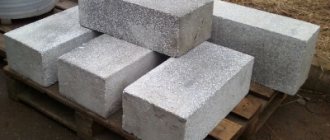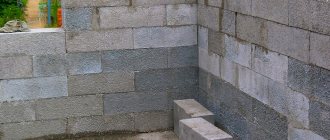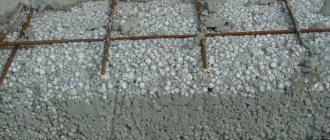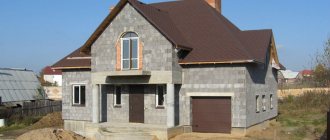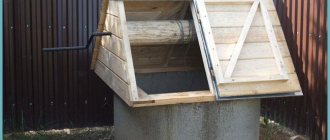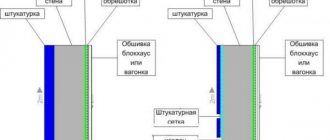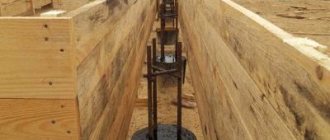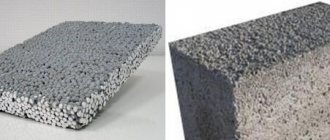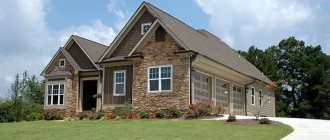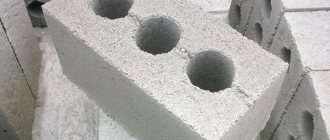Do you dream of building an energy-efficient building with your own hands where you will live with your family? Get acquainted with projects made from polystyrene concrete blocks. Construction companies are engaged in their creation. You can build a house made of polystyrene concrete with your own hands. Lightweight material has excellent performance properties. Its advantages are high quality and excellent thermal insulation of a private home.
Project of a two-story house made of polystyrene concrete covered with siding
Construction is cheaper compared to using other materials.
Production of PSB
Polystyrene concrete is produced industrially and by self-mixing.
Since all the ingredients are affordable and sold in stores without restrictions, homemade production is quite popular in individual construction. To reduce the cost of self-mixed concrete, crushed packaging foam is used instead of granules.
Crushed material has a wide variation in particle size distribution, which makes it difficult to obtain PSB with high strength characteristics.
For do-it-yourself production, the composition and proportions of the mixture components are determined based on the requirements for the density (weight of 1 m3) of the finished material.
“Recipe” for preparing 1 m3 of polystyrene concrete D400:
- cement – 330 kg;
- water – 150 l;
- polystyrene granules – 1 m3;
- foaming agent – 1 kg.
Some home craftsmen manage to make a homogeneous mixture using a shovel in a trough, but professionals recommend using a concrete mixer.
To obtain a homogeneous solution that is not prone to separation, it is necessary to observe the proportions and sequence of loading into the stirrer drum:
- Pour in the granules, add 1/10 of the water and modifiers.
- Mix the contents of the mixer for at least 30 seconds to evenly moisten the polystyrene.
- Add cement.
- Add remaining water and air-entraining additive.
- Stir for 3 – 5 minutes.
The finished solution is loaded into formwork, which is removed after hardening. The material gains its design strength 28 days after pouring. To obtain piece blocks, metal formwork is most often used.
It is also possible to produce a polystyrene concrete mass followed by sawing.
The most popular blocks are the following sizes:
- wall – 150 × 295 (300) × 600, 330 × 295 (300) × 600; 400 × 295 (300) × 600;
- partition – 92 × 600 × 600;
- reinforced lintels – 1300 × 300.
The price of finished PSB in Russia is 3-4 thousand rubles per 1 m3, depending on the brand of density.
Cost of polystyrene concrete products
In general, the cost of PSB blocks is 10-15% higher than that of foam and aerated concrete analogues. The price of polystyrene concrete blocks is determined primarily by the size and grade of material (structural or thermal insulation). Products with decorative finishing are 20-30% more expensive than construction products.
For a block measuring 595x375x295 mm, the average price in the Moscow region (per 1 m3, excluding delivery costs, depending on the brand) is:
- D-250 - 3000-3200 rub.
- D-300 - 3300-3400 rub.
- D-350 — 3450-3550 rub.
- D-400 — 3650-3750 rub.
- D-450 — 3800-3850 rub.
- D-500 — 3750-3950 rub.
- D-600 - 4250-4300 rub.
Walls made of PSB blocks with claddingSource isd-group.ru
Production of polystyrene concrete
First, a little about production technology. For the manufacture of any building blocks, polystyrene foam is no exception, it is better to use the pressing method, or even better, vibrocompression of the material. This greatly increases its stability, and hence its service life.
The production of polystyrene foam blocks can be done in two main ways:
- Casting the solution into cassette molds.
- Volumetric vibrocompression of rigid mixtures.
In both cases, the stages of polystyrene concrete production are similar, but there are some technological differences.
Injection molding method
The most common method of producing masonry material is casting into movable, plastic forms. At the filling site, the molds must be lubricated from the inside with a special lubricant. When there is a need to pour the mixture into the formwork, it is installed directly in the place where it is advisable to use polystyrene concrete.
Typically, the cassette method for producing polystyrene blocks involves the use of stable solutions of medium and low density. When producing a large number of blocks, it is advisable to use a foam generator.
This device can continuously supply foam solutions to the concrete mixing tank. You also need to add the required amount of PSV granules there. Finished blocks of medium and low density have a rather low thermal conductivity coefficient.
The disadvantages of the technological process include only 2 facts:
- Good cassettes are expensive.
- It is quite difficult to remove finished blocks from molds, which increases labor costs.
However, with a well-established process for manufacturing a large number of polystyrene blocks, these disadvantages are offset by production volumes.
Vibration pressing
For this method, it is only possible to use polystyrene mixtures with low water content and high cement content. The production of blocks is possible only with the help of vibrocompression equipment.
It happens like this:
- The prepared mixture is fed in portions into the molding machine.
- On the molding trays, which are changed, the process of vibration compaction occurs to a semi-dry state.
- Semi-finished products on pallets are sent to a drying chamber, where they are kept for a certain time.
Finished polystyrene blocks have the stiffest density. The advantages of this technological process:
- The quality of the blocks is the highest.
- There is no need to use cassette forms.
The video will tell and show how the production of polystyrene concrete blocks into molds is carried out:
https://youtube.com/watch?v=7PL2nbw1KQY
Necessary materials
How to make polystyrene concrete with your own hands? You will need the following ingredients:
- Cement.
- Pre-sifted sand.
- Polystyrene.
- Water depending on the required consistency. The composition should not be liquid. Otherwise, the surface floats and does not gain the necessary strength. If there is insufficient fluid, the risk of cracking increases.
- Plasticizer. This role is played by a detergent.
The components require careful mixing. For this, it is advisable to use special equipment. This will also significantly speed up the construction process.
Construction management
Relatively recently, polystyrene concrete began to be used. Monolithic walls made of material have a number of advantages. The material has excellent performance properties. Even floor slabs are made from it.
Advantages of using polystyrene concrete in construction:
- High strength and rigidity of structures.
- PSB is characterized by lower weight in contrast to conventional concrete.
- Thermal insulation.
- Increased strength with a significant reduction in the weight of walls and ceilings.
- Simplicity of installation work.
- Increasing the speed of construction of a structure.
Methods for producing polystyrene concrete.
You can make polystyrene concrete with your own hands manually - in an open bath, or mechanically, using mixing equipment - a concrete mixer, a construction mixer. With the manual method, cement, sand, water and resin are first mixed, and then polystyrene is gradually added in small portions. This sequence of operations ensures high-quality mixing of the ingredients.
You will be interested in this article – Making artificial stone.
When mechanizing the technological process, polystyrene and part of the water are loaded into the concrete mixer, and after a little mixing (wetting the foam), cement is added, and then the remaining components. The total duration of the mixing stage should be at least 5 minutes. The finished mixture is poured into the formwork of the desired shape, and then the frozen blocks are kept for 24 hours at normal temperature. Disadvantages include the labor-intensive nature of technological operations and a high proportion of manual labor.
The main advantages of polystyrene concrete are:
- efficiency,
- versatility,
- durability,
- resistance to temperature changes,
- fire resistance,
- hydrophobicity.
The technological process for producing blocks from polystyrene concrete is constantly being improved, which means its areas of application are expanding.
Construction of houses
Monolithic polystyrene concrete helps owners save on bills for heat, gas or electricity. Large block material gives the walls stability. The likelihood of cracks forming from soil movement is minimized.
Reinforced lintels are made from PSB. The building becomes as stable as possible and does not suffer from seismological activity. The wishes of the consumer are taken into account. The project is created completely, including external finishing.
Wall blocks have a perfectly flat surface. They can be used in conjunction with any finishing material. Siding, brick and stucco are popular. The consumer can select blocks of the required thickness and size. The manufacturer offers convenient and practical options for length and width.
Expanded polystyrene concrete is the undisputed leader among materials in this group. In terms of technical characteristics, it is ahead of its competitors. The structure stands firmly on the foundation and does not crack due to temperature changes. There is minimal load on the ground. Comfortable conditions are created inside the house. The owner saves on heating bills. The material consists of natural components, so it cannot negatively affect human health. Builders note the ease of installation and maintenance. If repairs are necessary, they can be carried out in a few minutes.
Methods for combining concrete and foam plastic
Three main methods can be distinguished:
Insulation with pages
This option involves the creation of an insulating layer, in other words, the mentioned material is used with your own hands, like every insulation:
Placed under the screed before pouring.
Is it possible to insulate aerated concrete with polystyrene foam? In this case, yes. This is by and large a universal method that can be combined with any other building materials.
Expanded polystyrene has its own classification, which is detailed in the following table and will help you make the right choice:
| Brand | Density, kg/m3 | Compressive strength, MPa | Bending strength, MPa | Thermal conductivity, W/(m?K) | Burning time, seconds | Duration of work, years |
| PSB – S 15 | 10-11 | 0,05 | 0,07 | 0,037 | 3 | 20-50 |
| PSB – S 25 | 15-16 | 0,1 | 0,18 | 0,035 | 3 | 20-50 |
| PSB – S 25 F | 16-17 | 0,12 | 0,2 | 0,037 | 3 | 20-50 |
| PSB – S 35 | 25-27 | 0,16 | 0,25 | 0,033 | 3 | 20-50 |
| PSB – S 50 | 35-37 | 0,16 | 0,3 | 0,041 | 3 | 20-50 |
Mixing
The instructions for mixing the combined solution look like this:
- We load cement and sand into a concrete mixer in a ratio of one to two.
- Then we fill in the same amount of foam chips. If there are no ready-made balls, then it is possible to pass entire pages of foam plastic or their remains through a special crusher.
- After some mixing is completed, add water, the volume of which should be approximately half the volume of the loaded mixture.
- Stir until the solution reaches a homogeneous state, reminiscent of buckwheat porridge.
As a result, it turns out that the non-specialized proportions of all components look like this:
| Cement | Sand | Expanded polystyrene | Water |
| 1 | 2 | 3 | 3 |
The finished product will have the following advantages compared to pure concrete:
Reduced thermal conductivity. Significantly higher thermal insulation qualities due to the presence of foam particles.
- Light weight. Which indicates less load on the foundation. Moreover, it is much easier to work with such a solution.
- Increased sound insulation. Noise that may travel through the cement stone will be absorbed by the polystyrene balls.
- Lower price. Polystyrene foam is much cheaper than other concrete ingredients, especially taking into account the proportions used, which accordingly significantly affects the final price of the screed.
But one feature is still getting worse. This is strength. And in order for this parameter to remain within normal limits, you need to carefully monitor the ratio of the insulating additive in relation to other components.
Permanent formwork
The use of a permanent frame made of foam plastic for pouring concrete is a fairly progressive and effective way of constructing and insulating buildings, which provides many advantages:
Variety of poured designs. Expanded polystyrene formwork can have any shape: arch, column, beam, corner, and so on. This significantly increases the number of design solutions.
- Ease of handling. You only need to install the desired structure, which already has reinforcing rods, and fill it with cement mortar. In addition, there is no need for preliminary installation of wooden formwork.
- Ease of processing. Blocks are cut using a sharp knife without any special equipment; the same method is used to create grooves for electrical wiring.
- Solidity of the finished structure. The absence of joining seams gives additional advantages to thermal insulation and strength.
- High speed of installation work. A simple box of a small private house is built in seven days.
The only point that can be considered a minus is the need for external finishing work. But, if you want to end up with a building with a beautiful facade, then additional finishing will be useful when using virtually any building material. In this case, simple plastering is suitable.
Comparison of the cost of constructing 1m2 of external wall
The cost of work and materials is indicated as of February 2017.
COMPARISON OF THE COST OF 1 M2 OF EXTERNAL WALL WITH FAÇADE INSULATION WITHOUT FINAL FINISH Name of work and costs Cost of 1 m2, rub. 1. POLYSTYRENE CONCRETE Laying of walls (at the rate of 1400 rub/m3) m21280280 Application of reinforcing layers 21200200 Polystyrene blocks tones 0.2x0.3x0.6m (4250rub/m3)m21850850Glue for masonry kg 87.862.4 Plaster reinforcing mesh m21.12426.4 Reinforcing adhesive kg 414.256.8 TOTAL: 14762. AERED CONCRETE (Insulation system with foam boards) Wall masonry (at the rate of 1400 rub/m3) m21280280 Wall insulation with polystyrene foam mm 21200200 Application of ar aerated layers21200200Aerated concrete blocks (4000rub/m2)m21800800Masonry adhesivekg87 ,862 Adhesive for gluing foam plastic slabs and reinforcement kg 912, 4112 Foam plastic 218787 Anchors for fastening foam plastic slabs 61,710 Plaster reinforcing mesh 21,12426 TOTAL: 17783. AEROSCATED CONCRETE (Insulation system with basalt slabs) Wall masonry (at the rate of 1400 rub/m3) m21280 280Wall insulation with basalt slabs21400400Applying reinforcing layers21200200Aerated concrete blocks (4000rub/m2 ) m21800800 Adhesive for masonry kg 87,862,4 Adhesive for gluing basalt slabs and reinforcement kg 1014,4144 Technoblock with a density of 45 and higher 21210210 Anchors for fastening basalt slabs 61,710 Plaster reinforcing mesh 21,12426 TOTAL: 21334. SHELL ROCK STONEMasonry of walls (at the rate of 30.8 pcs/m2) m21616616Plastering of walls for facades21220220Wall insulation with polystyrene foammm21200200Applying reinforcing layers21200200Shell stone (at a cost of 20rub/pc)m21616616Masonry mortar (approximately 25% of the masonry volume) m30.0955000475 Plaster mortar (based on a layer thickness of 2 cm) m30 ,02480096Adhesive for gluing foam boards and reinforcementkg912.4112Foam218787Anchors for fastening foam boards61.710Plastering reinforcing mesh21.12426TOTAL:2658
What supplies and tools will be needed?
To build a bathhouse you will need the following tools:
- hammer;
- order;
- level;
- lace;
- trowel;
- plumb line;
- container for mixing the solution;
- a spatula with teeth or a special container;
- electric drill with attachment.
The list shows the minimum that is needed only for the construction of walls. For foundation work, you will also need a concrete mixer, roofing material, a laser level, a water level, and a square. To equip the roof, you need the material from which the flooring will be made, as well as metal or wooden structures to create a rafter-beam system.
You also need to prepare a cinder block in the required quantity and a solution. The solution used is a cement-sand mixture, which is mixed with water in a concrete mixer or bucket using a drill.
Walls
To install walls made of polystyrene concrete, you can use several methods:
- block masonry;
- a monolithic house made of polystyrene concrete can be made with removable and permanent formwork.
Block masonry
Laying begins from the highest corner of the base.
Usually, ready-made or self-cast polystyrene concrete blocks are used to build a house. In this case, the installation of the walls of the house is carried out in the following order:
- Laying begins from the highest corner of the base. But first you need to perform horizontal waterproofing of the foundation. The concrete surface of the base must be insulated with two layers of roofing material on bitumen mastic.
- The first row is laid on a layer of mortar no more than 3 cm high. The first block is leveled.
- Next, a corner element is laid on the adjacent corner, to which the masonry will be laid from the first block.
- Then in the corners the masonry is brought up several rows. In this case, block releases are left for dressing the masonry.
- A fishing line is stretched between the erected corners. When laying each subsequent row, the line rises to a higher level. The verticality of the walls is constantly controlled by a level or plumb line.
Attention: if blocks with through voids are laid, then vertical reinforcement of the wall must be performed. If you use factory blocks, then you need to insert a sealing cord into the grooves, and do horizontal reinforcement of the walls every few rows (see photo).
- It is also worth remembering that the thickness of the seam should not exceed 8 mm, so that cold bridges do not arise, which will worsen the thermal insulation qualities of the structure. Instead of a solution, it is better to use special glue. It gives better adhesion of elements to each other than a conventional cement-sand mixture.
Removable formwork
If you are building a house using a monolithic method, then you need to find suitable formwork
If you are building a house using a monolithic method, then you need to find suitable formwork. For these purposes, plywood 1.5 cm thick is suitable. To protect it from moisture, the plywood can be wrapped in plastic film. You will also need a clamp for the width of the wall with formwork. To make the work easier, you need to make a comb - this is a piece of profile pipe 50 mm longer than the wall thickness with reinforcement bars 10 cm long welded to it. Further work is carried out as follows:
- First, the starting profile is mounted on one of the corners of the house. It is selected based on the thickness of the plywood. This profile is attached using self-tapping screws and dowels to the concrete base.
- Then two sheets of plywood are inserted into the profile so that a right angle is formed. The plywood is connected with metal corners.
- After completing the installation of the external corners, the internal corners are made of plywood in the same way. In this case, a pre-made comb will help make your work easier. This device is inserted with teeth between the plywood and holds one sheet while the other is attached. Internal corners are also fixed with steel corners.
- We cover the ends with profile strips. The plank should have a protrusion like a spike, which, after the solution hardens, will provide a recess necessary for a tight fit of the next layer without cold bridges.
- To press the end strip tightly, we use a clamp.
- We prepare the mixture in the same proportion as for pouring polystyrene concrete blocks.
- After pouring the solution into the formwork, it is thoroughly compacted.
- Next, the formwork for the next layer is installed. Moreover, it can be poured without waiting for the previous layer to completely harden. When pouring the next layer, the shields from the previous one are not removed.
- The formwork can be removed after 5-7 days.
Permanent formwork
Installation with permanent formwork allows you to immediately finish the walls of the house
Installation with permanent formwork allows you to immediately finish the walls of the house. The essence of the method is that the space between two brick walls is filled with polystyrene concrete mortar. We work like this:
What materials are best to build houses from?
- We begin the installation of walls from the highest corner of the base.
- First, we carry out brickwork on the outer and inner surfaces of the walls. During the installation process we make dressings. At the same time, we turn the interlocking brick inward through the row so that it serves as wall reinforcement.
- Pouring is carried out simultaneously with the masonry construction process.
Important: before starting the installation of walls, it is worth noting the locations of door and window openings. To do this, you can prepare simplified frames from boards, accurately observing the dimensions of the future blocks.
Installation of windows and doors can be done immediately after installing the roof of the house. The thing is that the structure is absolutely not subject to shrinkage, so there is no need to wait several months before starting finishing work.
Performance overview
The material parameters are regulated by GOST 51263-99, grades are classified according to strength, density and frost resistance. The main operating values include:
- Thermal conductivity coefficient is in the range of 0.055-0.145 W/m·K.
- Density – 150-600 kg/m3.
- Compressive strength – up to 3.6 MPa.
- Frost resistance – from 35 to 300 cycles.
- Vapor permeability coefficient – no more than 0.5 mg/m·h·Pa.
Compliance with fire safety standards deserves special mention. Polystyrene concrete has a flammability group of G1 and is classified as a low-flammable substance with low and moderate smoke-generating ability (B1 and D1, D2). But it cannot be classified as heat-resistant and cannot be used as a fire-retardant material. Reviews note that when there is direct or close proximity to an open fire or areas with high temperatures, the polystyrene foam filler begins to collapse, which negatively affects the insulating and strength properties of the block. But for private construction it is suitable and fully complies with both fire and sanitary safety standards.
Reviews about blocks and houses made of polystyrene concrete
“I built a summer kitchen from blocks with foam chips with a density of 400, and during the laying process I was completely satisfied with the material. Among the advantages, I can note quick installation, lightness, good heat retention even without connected heating. I finished construction in the fall, didn’t have time to do the finishing, and then discovered some disadvantages. The windward side became almost completely wet during the winter cycle with good rain. The finishing work took a lot of money due to the need for a thick layer of plaster and reinforcement on both sides.”
Ivan, Krasnodar.
“I am the owner of a one-story cottage made of polystyrene blocks with a density of 500, laid in two rows. In my opinion, they have only one minus - poor vapor permeability, while the finishing was going on, the feeling of a steam room was created inside the room, but after that it went away. There are more advantages: quick self-installation, ease of processing, the house keeps heat well and for a long time, four years after the completion of all repairs there are no complaints.”
Ilya, Moscow.
“From my own experience in building a one-story house, I advise you to buy blocks only from certified manufacturers, preferably with a long history; I personally have come across many fakes. Polystyrene concrete has operational disadvantages, but these can be eliminated with the help of modern finishing materials. The advantages include good insulation properties; when laying in two blocks, insulation is not needed.”
Dmitry, Irkutsk.
“I used D300 polystyrene concrete blocks as insulation for an old cinder block house. I am pleased with the result: it became much warmer inside, saving on heating was 35 percent. The outer walls, unlike foam plastic, do not break with any impact, birds and mice have not disturbed the appearance in 3 years. So I recommend it as insulation.”
Sergey, Moscow region.
“I bought polystyrene concrete blocks when building a country house. What I can say from my own observation: look for a certified product, after installation, let the house sit for at least a year, there is a lot of shrinkage, although there are no cracks in the walls, but the plaster is bursting. There is also the problem of fasteners; everything is held together only by cement mortar. But in the end, the dacha turned out to be quite warm; to maintain heat in winter, it is necessary to warm it up sometimes and it lasts for a week (we live in it on short visits). So I’m happy with the material.”
Roman, Moscow.
“The walls of the carpentry shop, 20 by 5 m, were erected from polystyrene blocks, the thickness was 300 mm, they were plastered on the outside, and left unfinished on the inside. As a result, the costs were small, the heat remains even in frosty conditions of -25° without intensive heating. The downside is that there is no point in hanging anything on the walls (shelves fall down), only shelving helps. Also, after 2 years, I reinstalled the entrance doors (the hinge was completely loose), and I had to cover everything with mortar at the fastening points.”
Andrey, Yekaterinburg.
Construction of a cottage from PSB blocks
A house made of polystyrene concrete with an area of 100-120 m2 on two floors can be erected in approximately 3 months. The process goes through the following stages:
- Foundation. The total weight of the structure is small, so the foundation is made less massive. Filling the basement walls with liquid polystyrene concrete makes it truly dry and warm.
- Walling. The structure grows quickly, but the blocks require careful installation; A reinforcing mesh is laid on top of each row, increasing the rigidity of the structure. To prevent the formation of cold bridges, the thickness of the glue in the seams is kept to a minimum.
Pouring interfloor slabSource rmnt.net
- Floor and ceiling coverings. They are made from PSB blocks or filled with liquid mortar. Before screeding the floor, water distribution throughout the house is arranged.
- Roof and communications. Installed in accordance with the project.
- Exterior finishing. It is carried out taking into account the characteristics of polystyrene concrete. Decorative facade PSB blocks with a textured front surface or plaster are popular.
About sawing polystyrene concrete in the following video:
A little about quality
There are no problems with building a house from polystyrene concrete blocks - this is a common building material. To determine the quality of products, you must remember:
- High-quality products are equipped with a certificate that lists the characteristics of the material.
- The choice of product brand depends on the type of structure (residential building or outbuilding). The standard size of a regular PSB block is 188x300x588, a large one is 380x300x588 mm.
Low-quality polystyrene concrete blocks break with one blowSource beton-house.com
- The durable PSB block can withstand a fall from a height of 3-4 m or several blows with a sledgehammer.
- The granules on the cut of the material are clearly distinguishable, have the same size and are evenly spaced, adjacent to each other.
- The material must not have voids.
Phased construction of a polystyrene concrete house
Wall blocks made of polystyrene concrete - ready for work
So, you’ve probably already decided for yourself whether this material is right for you. And if you told him yes, then you can count on the construction of the structure in just 3-4 weeks (not counting the foundation), if you work without breaks and with a friendly team.
Foundation structure
The beginning of any construction is laying the foundation, and, as we have already said, it can be lightweight for a polystyrene concrete house.
You can choose the appropriate option for yourself from the following types:
Pile foundation - birch logs are used only as supports for the formwork
- Pile foundation - reinforced concrete and metal options are suitable;
Columnar foundation with a grillage made of metal channel
- Columnar foundation;
Pouring a strip foundation with channel logs
- Strip foundation is the most material-intensive solution.
You need to choose the type of foundation taking into account the characteristics of the soil on which you will build and the climatic conditions in your place of residence.
This foundation will last an incredibly long time.
- The most universal solution in this case is the use of a pile foundation, since it can be used on almost any type of soil. It is especially advantageous to take the metal version, since it can be installed in just a couple of hours, scalded with a grillage made from a channel, and immediately begin building walls.
- The second in speed and convenience will be a columnar foundation, and the most extended in time will be the strip version, since although the concrete in it may be of a low class, it still requires 28 days to gain its strength.
Pile tying options
- The speed of installation of columnar and pile foundations will also depend on the type of grillage used. In some cases, it is made of reinforced concrete, which similarly extends the work over the already announced period.
Formwork for a concrete grillage on metal piles
Let's take that same pile foundation as an example and find out the procedure for its installation:
- The first step is to clear the site for future construction. It is necessary to level it and remove the turf - the plant layer - from it.
The markings must be correct, otherwise the walls of the house will be crooked
- Next, precise markings are made using pegs and threads stretched between them. The main markings should follow the outline of the house. All angles are made right unless otherwise planned, which can be achieved by using the Pythagorean theorem about the legs and hypotenuse, as well as checking the length of the diagonals, which must be equal.
- According to the power of the future grillage and the piles themselves, we place marks for the places where the piles will be screwed in. It is difficult to make such a calculation without the necessary preparation, so without a project you have to use common sense, often playing it safe. A step of 1.5-2 meters is usually sufficient.
Installation of screw piles
- Next, at the marked points, the piles are screwed in to the required depth, which depends on the depth of soil freezing in the region. Installation can be done manually, as shown in the photo above, or you can use the services of special equipment for a fee. The price for the work is not that high, so if you want to speed things up as much as possible, we use such services.
Trimming piles to level
- Depending on the terrain, the piles can be screwed in to different heights, so after installation they need to be cut to the same level. We mark it with a laser axle builder or everyone’s favorite hydraulic level.
- Cutting is done with a grinder.
Advice! All piles must be installed strictly horizontally, therefore, at the moment of screwing, be sure to control their position with a level.
The result is satisfactory
- Next comes the turn of installing the grillage. We have already attached a diagram with all possible options, so choose the most optimal one for yourself - in our opinion, this is a metal channel that can be welded on in the shortest possible time, and you can immediately continue working.
Many people often ask the question: is it possible to lay a plinth made of polystyrene concrete blocks? In the case of building a house, the answer will be negative. The base is the above-ground part of the foundation, and the strength of polystyrene concrete will not be enough for it.
For these purposes you can use:
- Heavy concrete (FBS blocks);
- Expanded clay concrete blocks;
- Red brick;
- Rubble masonry;
- Rubble concrete;
- Reinforced concrete;
However, there is still the option of using polystyrene concrete blocks for the foundation and plinth, but only as permanent formwork.
Block for permanent formwork
And to be completely frank, such a plinth can be laid out under a very light structure - for example, if a bathhouse is being built from polystyrene concrete.
Bathhouse made of polystyrene concrete blocks
Roof
The roof can be anything
A house made of polystyrene concrete does not limit the customer in what kind of roof will be installed. As a rafter system, you can choose one-, two-slope or multi-slope. The attic space can be left as an attic. When calculating the roof, it is necessary to take into account weather conditions and the maximum gusts of wind that may occur in a particular area. This will make it possible to choose the optimal angle of inclination. The roof slope should protrude such a distance that running rainwater does not wash away the foundation. For this purpose, a blind area is also provided. The frame can be assembled from either wood or a lightweight metal profile. If you properly insulate the ceiling and flooring, then if you use the second option, the air will not freeze so much that it will lead to large heat losses. By the way, from the attic part of the ceiling, you can also make a screed using polystyrene concrete. It is lightweight, so it will not carry much load.
Are there any disadvantages
Structure of polystyrene concrete
Here are just some of the reasons for the high popularity of expanded polystyrene concrete:
- light weight;
- the ability to give any shape;
- ease of construction;
- the ability to create a monolithic house;
- resistance to high temperature and fire;
- sufficient density for comfortable hanging of furniture and other products;
- excellent thermal insulation;
- soundproofing characteristics allow you to cut off waves up to 72 dB;
- there is no need to use heavy equipment when constructing a structure and delivering materials;
- significant cost savings compared to other brick-lined blocks;
- Easy to fit blocks even with a regular hacksaw.
The disadvantages include poor vapor permeability, which can lead to moisture accumulation, as well as the fact that it is unknown how foamed polystyrene behaves over time. The level of styrene that is released into the air remains uninvestigated. Also, after a strong fire, the walls will have to be completely demolished; although the block does not burn, it loses its strength and also emits toxic gases. But even in such an emergency situation, there is no need to doubt the reliability of the structure.
More details about the advantages and disadvantages of the material are described in the video:
Advantages of polystyrene concrete blocks
The main advantages of polystyrene concrete blocks for wall construction:
- No need for additional insulation.
- Low thermal conductivity. The interior will be warm in winter, which will reduce heating costs.
- High-quality sound insulation, the value of which does not exceed 37 dB. Thin seams provide additional noise protection.
- Lightness of building elements. The weight of one block is 22 kg, but it replaces 17 bricks. This feature makes them easier to transport and also does not require pouring a massive foundation.
- Easy to install.
There is no need to hire builders to construct the facility. You can cope with this task on your own if you perform the correct calculations and use high-quality materials. - Resistance to environmental factors. The blocks are not afraid of frost and dampness, fungus does not multiply in them, insects and rodents do not settle in them.
- Durability. The objects have served their owners for more than 100 years.
- Environmental safety, compliance with sanitary and hygienic standards.
Polystyrene is a material that is used not only to make blocks, but also toys and yogurt cups. To ensure that the material does not contain harmful impurities, it must be purchased from manufacturers who provide quality certificates for their products. - Ease of processing when carrying out finishing work. This is relevant when performing repairs and laying communications.
- It is possible to mill, plan and trim elements without using complex tools.
- High speed of construction.
- High strength. Every year this indicator only improves, so houses made of modern polystyrene concrete blocks do not crack even during multi-story construction.
- Possibility of choosing blocks of different weights and strengths for the construction of load-bearing walls, lintels and partitions.
- Affordable price. The average cost of one element is 25-30 rubles, and one brick – 15 rubles. Moreover, each block can replace about 17 bricks or more. The benefit is obvious.
Properties and characteristics
The material has excellent thermal insulation ability with small wall thickness. A block of just 30 cm will retain as much heat as a standard brick wall.
Other properties and technical parameters of the material:
- strength – 0.73-3.6 MPa;
- maximum load – up to 35 t/linear. m with a thickness of 30 cm;
- resistance to fracture, bending – 0.08-0.73 MPa;
- frost resistance – up to 150 cycles;
- shrinkage – less than 1 mm per m²;
- fire resistance – class NG-G1 (non-flammable or low-flammable);
- noise insulation – sound absorption of 70 dB with a layer thickness of 30 cm;
- water absorption – less than 4%, excellent waterproofing properties;
- low risk of mold and mildew;
- service life - up to 100 years, gaining additional strength over time.
The material is vapor-permeable, so the walls allow moisture and air to pass through, breathe, providing a normal microclimate in the house. Polystyrene concrete is used in the temperature range from -60 to +70 degrees.
The raw materials for its production are environmentally friendly and safe. The material is not afraid of fire, since the surface granules do not ignite, but begin to evaporate.
Work order
You can buy ready-made polystyrene concrete in bags at any hardware store. However, the composition can be made with your own hands. The technology is simple and does not require special skills or acquired skill.
The components and additives for preparing the solution must be mixed using a special technology.
- At the first stage, you will need to measure the required amount of each component. In this case, the proportions are calculated in advance. Next, the substances are poured into a container in which further mixing will take place.
- The solution will be of high quality if its structure is homogeneous. Computers are not allowed.
- Further formation of blocks is carried out in special containers. Before starting work, the molds are lubricated with a special compound. It must contain machine oil. This will make it easy to remove them after they have hardened.
- The finished solution is poured into molds. It will need to be compacted thoroughly.
- It will take several days for the solution to completely harden. The total period depends on the ambient temperature and the amount of liquid included in the composition.
- It is also possible to fill an array. To cut it you will need special devices. As a rule, this option is used when there is a permanently connected line.
- The last step is drying. After a few days, it is possible to transfer the resulting blocks to pallets. The shelf life is unlimited. They can be sent to the warehouse.
- It is allowed to begin construction from the received blocks after a month. During this period, it gains strength that will correspond to the brand name.
Polystyrene concrete is a high-quality and lightweight material that is actively used in the construction of premises for various purposes. It has high technical characteristics. The production of blocks is carried out at the construction site or in a special workshop. In the second case, you will additionally have to think about transportation to the site. Ready-made blocks are also sold at hardware stores.
Construction of floors
In building construction, slabs provide an additional level of thermal insulation. It is advisable to use polystyrene concrete for arranging a flat roof. The surface will differ in the required adhesion. For waterproofing you will need to use additional material. In this case, the screed may not be performed.
PSB will not lose its properties under the influence of sudden temperature changes. It will preserve them in frost and excessive humidity. The surface is durable and will withstand snow loads.
